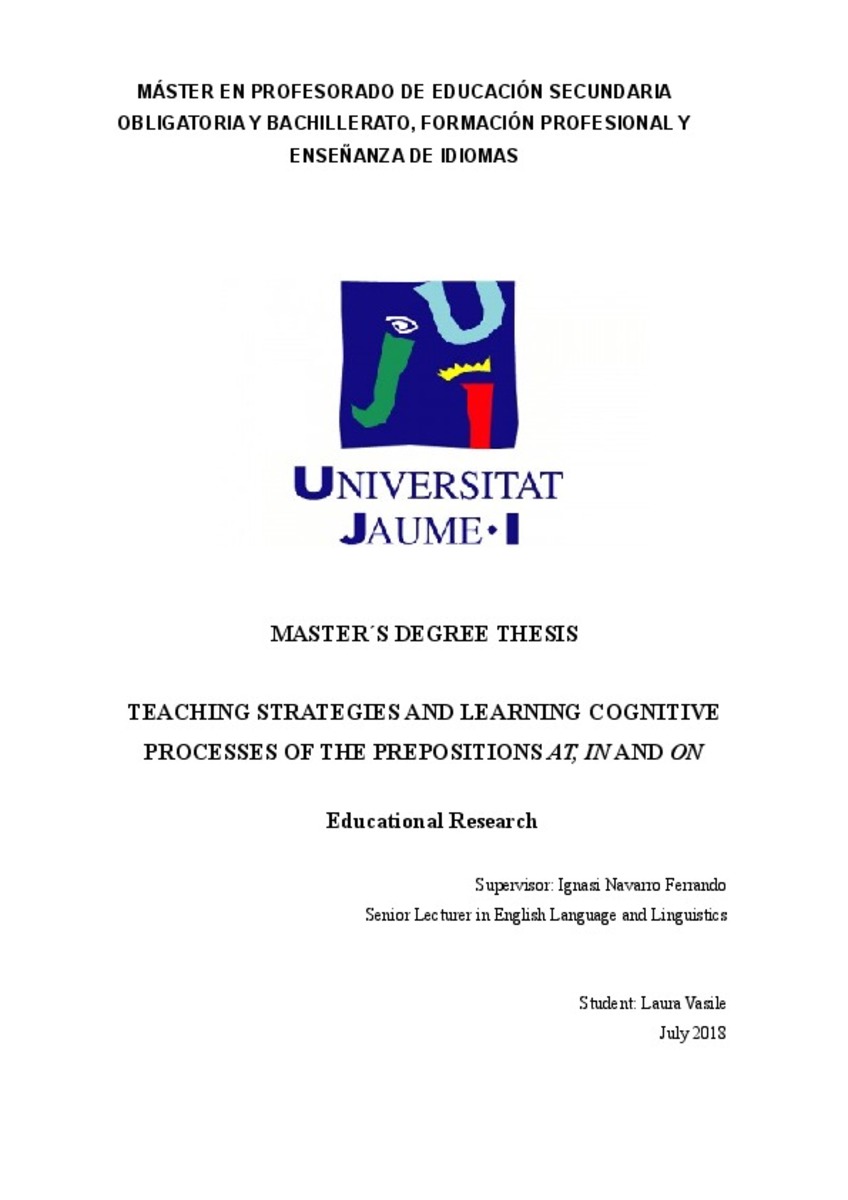Mostrar el registro sencillo del ítem
Teaching strategies and learning cognitive processes of the prepositions at, in and on
| dc.contributor.author | Vasile, Laura | |
| dc.contributor.other | Navarro i Ferrando, Ignasi | |
| dc.date.accessioned | 2018-12-10T15:57:29Z | |
| dc.date.available | 2018-12-10T15:57:29Z | |
| dc.date.issued | 2018-07-12 | |
| dc.identifier.uri | http://hdl.handle.net/10234/177985 | |
| dc.description | Treball Final de Màster Universitari en Professor/a d'Educació Secundària Obligatòria i Batxillerat, Formació Professional i Ensenyaments d'Idiomes. Codi SAP419. Curs: 2017/2018 | ca_CA |
| dc.description.abstract | This thesis explores the importance of teaching strategies and methods for prepositions´ learning, from a cognitive linguistic perspective. Prepositions are very difficult to be used correctly in English and they can cause more problems than any other parts of speech. Even though they are quite short, they play an important role and are crucial markers to the structure of a sentence. The present thesis consist of the following: First I discuss briefly the importance of English language nowadays and the role of English grammar in the teaching and learning process. Then I dedicate special attention to two strategies for teaching grammar, the deductive and the inductive approaches, and I explain the advantages and disadvantages of these two methods through the analysis of previous literature on the topic. After that I focus on the main topic of this thesis, which is prepositions and how they can be taught from a meaningful learning perspective. I describe first what prepositions are and their importance in English. Then, I investigate on the cognitive approach, its implications and ways about how to incorporate the teaching and learning of prepositions into Secondary School classes and their effectiveness. The last part consists of a research I carried out in a Secondary School during my practice period. In my research I make use of both traditional and modern methods taking into account that modern methods do not replace traditional methods but they are just additional resources. I use particularly the following techniques: the deductive and inductive methods and visual aids such as pictures. I also make use of games as very common technological tools for the young generation nowadays. The results show that both approaches, deductive and inductive, are effective with a slight difference in favour of the deductive strategy associated with the cognitive approach based on meaningful learning. | ca_CA |
| dc.format.mimetype | application/pdf | ca_CA |
| dc.language.iso | eng | ca_CA |
| dc.publisher | Universitat Jaume I | ca_CA |
| dc.rights | Attribution-NonCommercial-NoDerivatives 4.0 Internacional | * |
| dc.rights.uri | http://creativecommons.org/licenses/by-nc-nd/4.0/ | * |
| dc.subject | Màster Universitari en Professor/a d'Educació Secundària Obligatòria i Batxillerat, Formació Professional i Ensenyaments d'Idiomes | ca_CA |
| dc.subject | Máster Universitario en Profesor/a de Educación Secundaria Obligatoria y Bachillerato, Formación Profesional y Enseñanzas de Idiomas | ca_CA |
| dc.subject | Master's Degree in Secondary Education, Vocational Training and Language Teaching | ca_CA |
| dc.subject | teaching strategies | ca_CA |
| dc.subject | prepositions | ca_CA |
| dc.subject | learning cognitive processes | ca_CA |
| dc.title | Teaching strategies and learning cognitive processes of the prepositions at, in and on | ca_CA |
| dc.type | info:eu-repo/semantics/masterThesis | ca_CA |
| dc.educationLevel | Estudios de Postgrado | ca_CA |
| dc.rights.accessRights | info:eu-repo/semantics/openAccess | ca_CA |
Ficheros en el ítem
Este ítem aparece en la(s) siguiente(s) colección(ones)
-
TFM: Màster Universitari en Professor/a d'Educació Secundària Obligatòria i Batxillerat, Formació Professional i Ensenyaments d'Idiomes [1230]
SAP118, SAP119, SAP128, SAP129, SAP138, SAP139, SAP218, SAP219, SAP228,SAP229, SAP238, SAP239, SAP319, SAP419, SAP429, SAP509, SAP909, SAP709, SAP809








